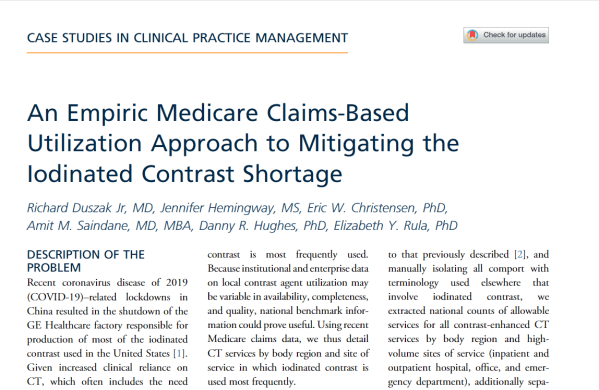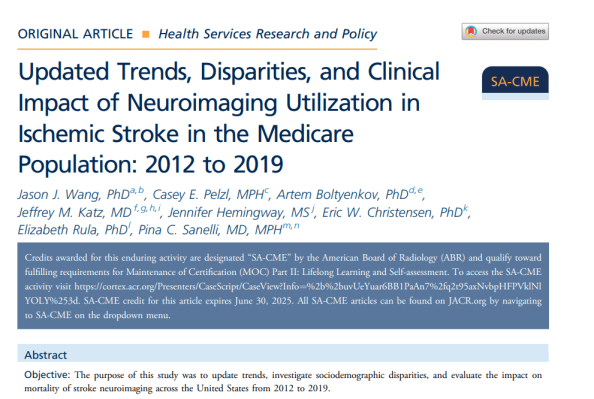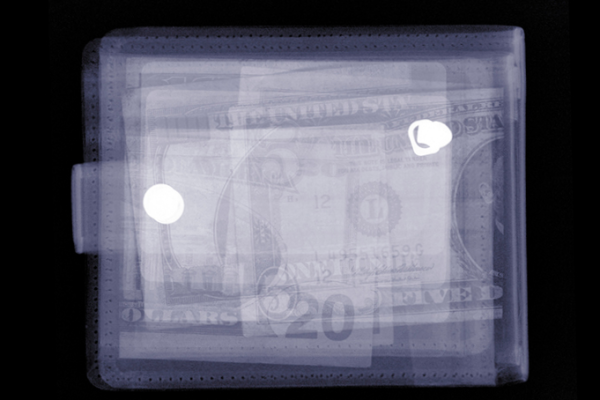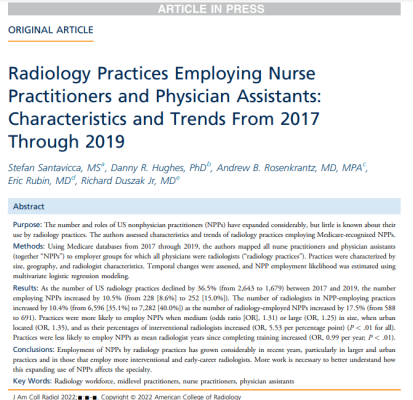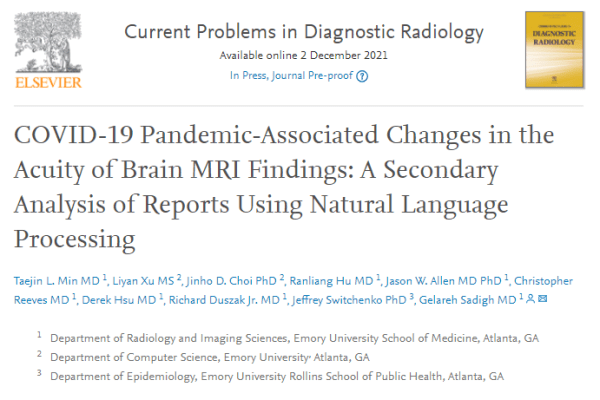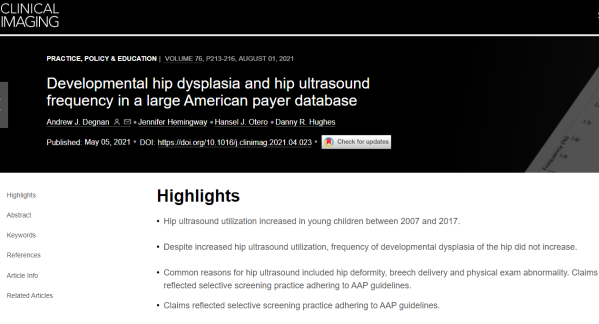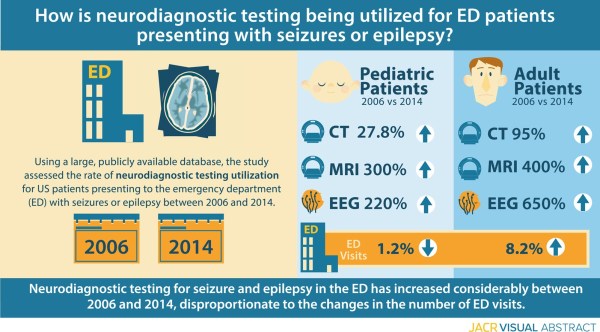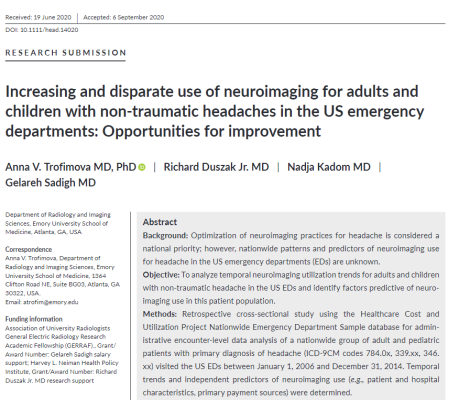The current shortage of iodinated contrast in the United States due to the COVID-19 related production shutdown in China is causing severe disruptions in patient care. A new Harvey L. Neiman Health Policy Institute study outlines the most frequently used computed tomography (CT) services performed on Medicare beneficiaries as focus areas for mitigation strategies for the greatest overall impact. Full Article
Richard Duszak Jr. MD, Jennifer Hemingway, MS, Eric W. Christensen, PhD, Amit M.Saindane, MD, MBA, Danny R.Hughes, PhD, Elizabeth Y. Rula, PhD. 2022. "An Empiric Medicare Claims-Based Utilization Approach to Mitigating the Iodinated Contrast Shortage," Journal of American College of Radiology (JACR), 19(7)
The purpose of this study was to update trends, investigate sociodemographic disparities, and evaluate the impact on mortality of stroke neuroimaging across the United States from 2012 to 2019. Full Article
Jason J. Wang, PhD, Casey E. Pelzl, MPH, Artem Boltyenkov, PhD, Jeffrey M. Katz, MD, Jennifer Hemingway, MS, Eric W. Christensen, PhD, Elizabeth Rula, PhD, Pina C. Sanelli, MD, MPH. 2022. "Updated Trends, Disparities, and Clinical Impact of Neuroimaging Utilization in Ischemic Stroke in the Medicare Population: 2012 to 2019," Journal of American College of Radiology (JACR), 19(7)
April 21, 2022
Consumer price listings may ultimately give consumers less of what they really want — high quality care. While transparent pricing is theoretically ideal for allowing patients to make informed decisions, the complexity of healthcare in the U.S. makes a truly transparent system a challenge and there are numerous caveats. Read the JACR Bulletin Column
The number and roles of US nonphysician practitioners (NPPs) have expanded considerably, but little is known about their use by radiology practices. The authors assessed characteristics and trends of radiology practices employing Medicare-recognized NPPs. Full Article
Stefan Santavicca, MS, Danny R. Hughes, PhD, Andrew B. Rosenkrantz, MD, MPA, Eric Rubin, MD, Richard Duszak Jr., MD. 2022. "Radiology Practices Employing Nurse Practitioners and Physician Assistants: Characteristics and Trends From 2017 Through 2019," Journal of American College of Radiology (JACR)
We aimed to assess early COVID-19 pandemic-associated changes in brain MRI examination frequency and acuity of imaging findings acuity. Full Article
Taejin L. Min, MD, Liyan Xu, MS,Jinho D.Choi, PhD, Ranliang Hu, MD, Jason W.Allen, MD,PhD, Christopher Reeves, MD, Derek Hsu,MD, Richard Duszak Jr.,MD, Jeffrey Switchenko, PhD, Gelareh Sadigh, MD. 2021. "COVID-19 Pandemic-Associated Changes in the Acuity of Brain MRI Findings: A Secondary Analysis of Reports Using Natural Language Processing," Current Problems in Diagnostic Radiology
Developmental dysplasia of the hip (DDH) is an important contributor to musculoskeletal morbidity, but effective strategies to screen for DDH remain controversial. The current utilization of hip ultrasound (US) screening for DDH in the United States is not defined. This study utilized Optum's de-identified Clinformatics® Data Mart, a large commercial and Medicare Advantage claims database. Full Article
Andrew J. Degnan, MD, Jennifer Hemingway, MS, Hansel Otero, Danny R. Hughes, PhD. 2021. "Developmental Hip Dysplasia and Hip Ultrasound Frequency in a Large American Payer Database," Clinical Imaging
March 19, 2021
The aim of this study was to assess neurodiagnostic testing utilization in US emergency department (ED) patients presenting with seizures or epilepsy between 2006 and 2014.
Optimization of neuroimaging practices for headache is considered a national priority; however, nationwide patterns and predictors of neuroimaging use for headache in the US emergency departments (EDs) are unknown. The objective of this study is to analyze temporal neuroimaging utilization trends for adults and children with non-traumatic headache in the US EDs and identify factors predictive of neuroimaging use in this patient population. Full Article
Trofimova Anna, MD, PhD, Richard Duszak Jr, MD, Nadja Kadom, MD, Gelareh Sadigh, MD. 2021. "Increasing and Disparate use of Neuroimaging for Adults and Children with Non‐Traumatic Headaches in the US Emergency Departments: Opportunities for Improvement," Headache
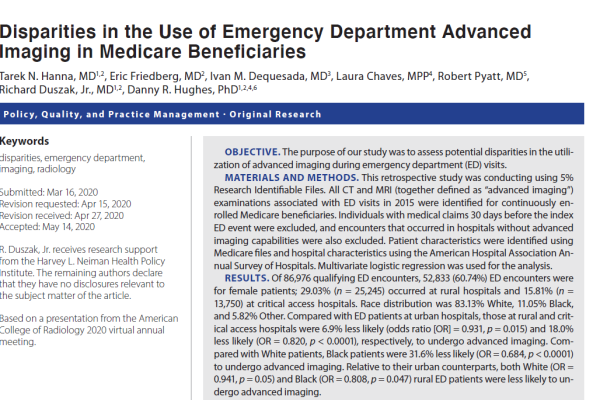
The purpose of this study was to assess potential disparities in the utilization of advanced imaging during emergency department (ED) visits. This retrospective study was conducting using 5% Research Identifiable Files. All CT and MRI (together defined as “advanced imaging”) examinations associated with ED visits in 2015 were identified for continuously enrolled Medicare beneficiaries. Among Medicare beneficiaries receiving care in U.S. EDs, significant disparities exist in advanced imaging utilization. Although imaging appropriateness was not investigated, these findings suggest inequity. Further research is necessary to understand why consistent health benefits do not translate into consistent imaging access among risk-adjusted ED patients. Full Article
Tarek N. Hanna, MD, Eric Friedberg, MD, Ivan M. Dequesada, MD, Laura Chaves, MPP, Robert Pyatt, MD, Richard Duszak, Jr., MD, Danny R. Hughes, PhD. 2021. "Disparities in the Use of Emergency Department Advanced Imaging in Medicare Beneficiaries," American Journal of Roentgenology
January 1, 2021
In the wake of COVID-19, the Harvey L. Neiman Health Policy Institute® studied imaging utilization in different settings over the course of 2020. Read the January 2021 ACR Bulletin Research Rounds column.

